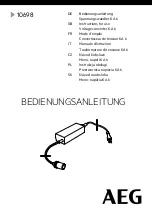
Chapter 4
Analog Input
4-12
ni.com
Finite sample mode acquisition refers to the acquisition of a specific,
predetermined number of data samples. Once the specified number of
samples has been read in, the acquisition stops. If you use a reference
trigger, you must use finite sample mode.
Continuous acquisition refers to the acquisition of an unspecified number
of samples. Instead of acquiring a set number of data samples and stopping,
a continuous acquisition continues until you stop the operation. Continuous
acquisition is also referred to as
double-buffered
or
circular-buffered
acquisition
.
If data cannot be transferred across the bus fast enough, the FIFO becomes
full. New acquisitions will overwrite data in the FIFO before it can be
transferred to host memory. The device generates an error in this case. With
continuous operations, if the user program does not read data out of the PC
buffer fast enough to keep up with the data transfer, the buffer could reach
an overflow condition, causing an error to be generated.
Non-Buffered
In non-buffered acquisitions, data is read directly from the FIFO on the
device. Typically, hardware-timed, non-buffered operations are used to
read single samples with known time increments between them.
Analog Input Triggering
Analog input supports three different triggering actions:
•
Start trigger
•
Reference trigger
•
Pause trigger
Refer to the
sections for information about these triggers.
An analog or digital trigger can initiate these actions. All M Series devices
support digital triggering, but some do not support analog triggering. To
find your device triggering options, refer to the specifications document for
your device.
















































